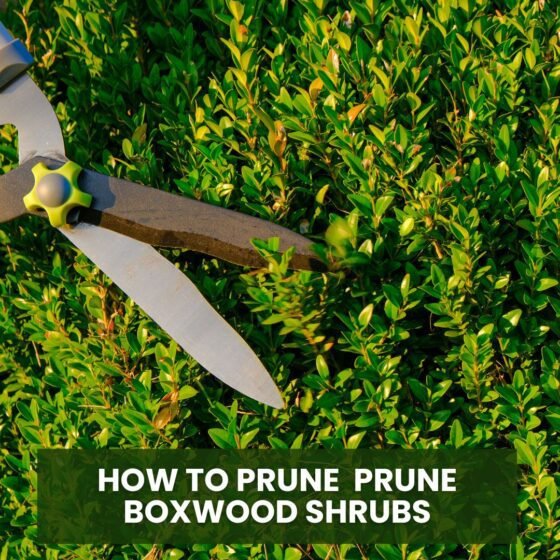How to Prune Boxwood Shrubs: Tips for Perfect Shape and Healthy Growth
Boxwood shrubs are a classic choice for landscapes, offering dense foliage, versatility, and year-round greenery.
Proper pruning is essential to maintain their elegant shape, promote healthy growth, and prevent overcrowding.
Learning how to prune boxwood shrubs helps create neat hedges, rounded topiaries, or natural shrub shapes while keeping your garden tidy and attractive.
Pruning also encourages stronger branches, improves airflow, and reduces the risk of disease.
Whether you’re shaping formal hedges or maintaining natural shrubs, these tips will ensure your boxwoods thrive and enhance your outdoor space. Below are 12 practical steps for pruning boxwood shrubs, along with maintenance and care tips for lasting results.

1. Understand Boxwood Growth
Before pruning, observe your boxwood’s growth habit. Boxwoods are slow-growing, dense shrubs with small, evergreen leaves. Recognizing which branches are weak, overgrown, or diseased will guide your pruning decisions.
2. Best Time to Prune
The ideal pruning periods are late winter to early spring before new growth begins and late summer for light shaping. Avoid heavy pruning in late fall to prevent damage from frost.
3. Use Clean, Sharp Tools
Always use sterilized pruning shears or hedge trimmers. Clean cuts minimize the risk of disease and help the plant heal quickly. Wipe tools with rubbing alcohol before use.
4. Remove Dead or Damaged Branches
Start by trimming any dead, damaged, or diseased stems. Removing unhealthy branches improves airflow and encourages healthy foliage growth while preventing pest infestations.
5. Thin Overcrowded Areas
Boxwoods can become dense, limiting sunlight and airflow. Remove inner branches that crowd the shrub to reduce fungal risks and promote vigorous outer growth.
6. Shape the Shrub
Decide on your desired shape—formal hedge, round topiary, or natural shrub. Carefully trim the outer layers while maintaining the plant’s natural structure, ensuring an even, aesthetically pleasing form.
7. Prune Gradually
Avoid cutting too much at once. Remove no more than 30% of the shrub in one session to prevent stress and allow the plant to recover. Gradual shaping ensures healthy regrowth.
8. Maintain Hedges and Lines
For formal hedges, use a level or string line as a guide. Trim slowly and evenly, keeping the base slightly wider than the top to allow sunlight to reach lower branches.
9. Encourage New Growth
Pruning stimulates new shoots from the base or inner branches. Cutting lightly above a leaf node or branching point encourages bushier, fuller shrubs.
10. Avoid Cutting into Old Wood
Boxwoods rarely produce new growth from old, woody stems. Focus pruning on green shoots and avoid excessive cuts into hard wood to prevent bare patches.
11. Clean Up Clippings
Remove trimmed branches and leaves immediately to prevent fungal spores from spreading. Regular clean-up maintains garden health and appearance.
12. Maintain a Regular Pruning Schedule
Light pruning every 6–8 weeks during the growing season keeps shrubs tidy, dense, and healthy. Consistent trimming prevents overgrowth and maintains your desired shape.
Boxwood Maintenance Tips
-
Water Properly: Keep soil consistently moist but well-drained. Boxwoods dislike waterlogged conditions, which can cause root rot.
-
Fertilize Annually: Apply slow-release fertilizer in spring to promote healthy growth and vibrant foliage.
-
Mulch Around the Base: A 2–3 inch layer of mulch conserves moisture, prevents weeds, and stabilizes soil temperature.
-
Monitor for Pests: Check for boxwood leafminer, mites, or fungal infections regularly. Early detection helps prevent damage.
-
Protect in Winter: Use burlap or anti-desiccant sprays to shield shrubs from harsh winter winds and frost damage.
Boxwood Care Tips
-
Light Requirements: Boxwoods thrive in full sun to partial shade. Ensure they get at least 4–6 hours of sunlight daily.
-
Soil Preference: Plant in well-draining soil with a slightly acidic to neutral pH for optimal growth.
-
Avoid Overcrowding: Space shrubs 3–5 feet apart to allow air circulation and healthy root development.
-
Regular Inspection: Look for yellowing leaves, stunted growth, or dieback to address issues early.
-
Support Young Shrubs: Stake new plants if necessary to maintain upright growth and prevent wind damage.
Final Thoughts
Pruning boxwood shrubs is key to achieving lush, dense, and perfectly shaped greenery in your garden.
By following these steps—removing dead branches, thinning crowded areas, shaping the plant, and maintaining a regular schedule—you can ensure your boxwoods remain healthy, elegant, and vibrant year-round.
Combining careful pruning with proper maintenance and care tips maximizes growth, reduces disease risk, and enhances the overall beauty of your landscape. Consistency and attention to detail make your boxwoods a standout feature in any garden.






